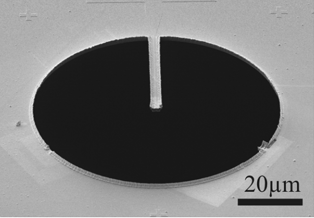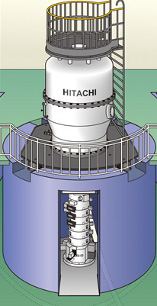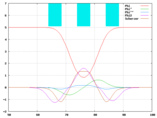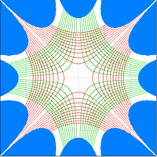Research
research projects in progress
Phase Plate
 CEOS is investigating the possibilities offered by using phase plates in electron microscopes together with Karlsruhe Institute of Technology (KIT) and Bioquant in Heidelberg. Phase contrast of weak objects in transmission can be strongly improved. We present a discussion of the questions involved in our basics. Informations about application and manufacturig of these phase plates can be found here. Please notice the second of the presentations mentioned there: Einfluss von Phasenplatten auf Kontrasttransfer in Cs-korrigiertem TEM.
CEOS is investigating the possibilities offered by using phase plates in electron microscopes together with Karlsruhe Institute of Technology (KIT) and Bioquant in Heidelberg. Phase contrast of weak objects in transmission can be strongly improved. We present a discussion of the questions involved in our basics. Informations about application and manufacturig of these phase plates can be found here. Please notice the second of the presentations mentioned there: Einfluss von Phasenplatten auf Kontrasttransfer in Cs-korrigiertem TEM.
completed projects
SALVE (Sub Angstrom Low Voltage Electron Microscopy)
 CEOS developed a corrector for chromatic, spherical and coma-aberration in a TEM together with FEI on behalf of the University of Ulm. The voltage applied can be varied from 20 to 80 kV. The development of a Cc/Cs-corrected low voltage electron microscope within the SALVE project has been successfully completed. Ulm University informed about their final acceptance of the instrument in a press release, containing detailed informations about the performance of the instrument. The instrument has been handed over to Ulm University. Until the new EM-Lab building at the university is finished, the microscope will be operated at CEOS' premises by Ulm University researchers. Follow the link to the website of this project.
CEOS developed a corrector for chromatic, spherical and coma-aberration in a TEM together with FEI on behalf of the University of Ulm. The voltage applied can be varied from 20 to 80 kV. The development of a Cc/Cs-corrected low voltage electron microscope within the SALVE project has been successfully completed. Ulm University informed about their final acceptance of the instrument in a press release, containing detailed informations about the performance of the instrument. The instrument has been handed over to Ulm University. Until the new EM-Lab building at the university is finished, the microscope will be operated at CEOS' premises by Ulm University researchers. Follow the link to the website of this project.
Cs-Corrector for 1.2 MV
 A corrector for spherical aberraton in the case of an acceleration voltage as high as 1.2 MV was designed and installed in the microscope. The project is completed resulting in a world record in resolution of 43 pm, reported in Appl. Phys. Lett..
A corrector for spherical aberraton in the case of an acceleration voltage as high as 1.2 MV was designed and installed in the microscope. The project is completed resulting in a world record in resolution of 43 pm, reported in Appl. Phys. Lett..
elektrostatic corrector
 CEOS developed a purely elektrostatic Cc/Cs-corrector. It could be shown that correcting chromatic and spherical aberration in a ion optical column significantly improves resolution.
CEOS developed a purely elektrostatic Cc/Cs-corrector. It could be shown that correcting chromatic and spherical aberration in a ion optical column significantly improves resolution.
C-COR
 Within the TEAM project CEOS has developed a magnetic/electrostatic Cc/Cs- corrector for a transmission electron microscope. It has been placed at the disposal of the scientific community at the user facility of NCEM in october 2009. There scientists are allowed to use it for their own purposes.
Within the TEAM project CEOS has developed a magnetic/electrostatic Cc/Cs- corrector for a transmission electron microscope. It has been placed at the disposal of the scientific community at the user facility of NCEM in october 2009. There scientists are allowed to use it for their own purposes.
A further C-COR was put in operation in Jülich within the scope of the PICO project.
Using the PICO instrument tomographic imaging of entire cells has been investigated. This shows impressively that chromatic correction is not only useful for highest resolution applications. Due to inelastic scattering in the thick cells the energy width of the electron beam is broadened to more than 200 eV, before they enter the imaging optics. Without chromatic correction the resolution would be limited to more than 10 nm. In the PICO instrument a resolution of 2-4 nm could be obtained.
In another publication from the PICO project Urban et. al. could show that elemental mapping with atomic resolution and energy windows as wide as 40 eV becomes possible in a chromatically corrected microscope.
The C-COR has meanwhile become a standard product of CEOS.
B-COR
 On behalf of the University of Victoria CEOS built an aplanatic corrector of the hexapole type. Correcting the spherical and off-axial coma aberration allows for an enlarged high-resolution field of view within the ccd camera. Further information can be found on this poster.
On behalf of the University of Victoria CEOS built an aplanatic corrector of the hexapole type. Correcting the spherical and off-axial coma aberration allows for an enlarged high-resolution field of view within the ccd camera. Further information can be found on this poster.
This corrector has been implemented into the same microscope as the S-CCOR mentioned below.
The B-COR has meanwhile become a standard product of CEOS.
S-CCOR
 On behalf of the University of Victoria CEOS developed together with Hitachi a corrector for chromatic and spherical aberration in a STEM. The microcope has been installed at the University and is now fully in service.
On behalf of the University of Victoria CEOS developed together with Hitachi a corrector for chromatic and spherical aberration in a STEM. The microcope has been installed at the University and is now fully in service.
More information about this project can be found on the pages of the University of Victoria, especially in the section "A little bit about technology" of the HF-33XX tab.
Future prospects
Applying correction in electron microscopes offers a variety of possibilities for development. Many restrictions, so far necessary for achieving high resolution, can now be dismissed. This applies to high acceleration voltages, strong objective lenses or the small energy width of the beam. Abandonment of these restrictions offers new prospects for the users.

